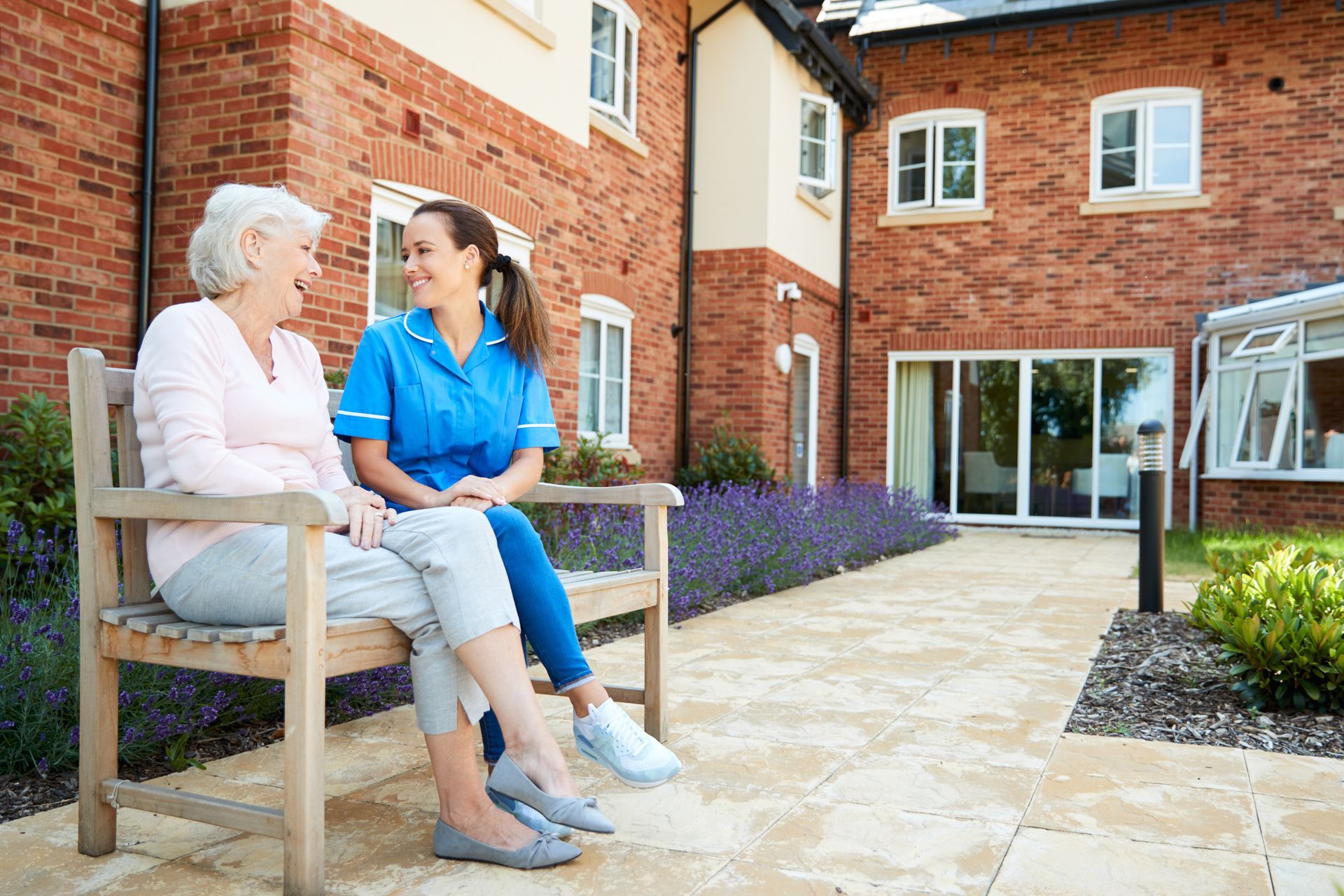BLOG
How to Manage Sundowning in Seniors with Alzheimer's
As the disease advances, many people with Alzheimer's may start having sundowning episodes. It can be upsetting for you as well as for your senior.
The reason for this behavior is not well understood. It can be a scary experience for anybody with Alzheimer's to face alone.
However, there are some things that you can do to help your senior relative or friend better manage this behavior.
What is sundowning?
In dementia patients, sundowning is a behavior change that occurs in the evening or at sunset. It's a general term used to describe a range of behaviors, including confusion, anxiety, fatigue, and sleeplessness.
Sundowning syndrome is not a disease but rather a collection of symptoms related to Alzheimer's disease and other forms of dementia. The symptoms may occur at any time of day but are most notable during late afternoon/evening hours when it begins to get dark outside.
What early symptoms should I look out for?
As your loved one's dementia progresses, they will likely experience a wide range of symptoms. These can include:
- Cognitive decline, including confusion and forgetfulness
- Increased anxiety/agitation or sleeplessness
- Hallucinations (seeing things that aren't there)
- Depression and irritability
Is sundowning temporary?
Is sundowning temporary or permanent? It's difficult to predict if sundowning will be temporary or if it will continue to occur indefinitely.
Some people have a few instances of sundowning, but then they never experience it again. Others experience recurring episodes of symptoms that get worse as time goes on.
Some factors can make the symptoms of sundown syndrome more severe or frequent, including:
- Tiredness
- Stress and anxiety
- Boredom and loneliness
- Hunger (or not eating enough during the day)
What triggers sundowning?
Because Alzheimer's is a progressive disease, it seems logical that sundowning symptoms would worsen as time goes on. However, this isn't always the case. Some people with Alzheimer's experience frequent and intense sundowning episodes later on in their disease, while others do not experience any.
For seniors who do experience sundowning, several triggers may set off an episode:
- Stress
- Irregular sleep habits (such as insomnia)
- Hunger
- Lack of exercise and physical activity
How to manage sundowning seniors with Alzheimer's
Sundowning can be a real problem for families of Alzheimer's patients. As you know, the disease affects the brain's ability to function properly and create new memories. That makes it harder for patients to remember things they did earlier in the day or even after eating breakfast that morning.
Symptoms like this can cause frustration, confusion, and agitation among patients who are not accustomed to these changes in their lives.
You can do a few things as a family member or caregiver that may help manage sundowning symptoms:
1. Look for triggers
As you begin to recognize the triggers that cause your loved one's sundowning behavior, you can start to plan around them. If they become agitated, find out what is causing it and avoid that situation as much as possible.
If they become anxious or angry when a specific person is nearby, do not put that person in the same room with them at night. The same goes for when they exhibit signs of agitation at a particular time of day—plan activities for those times instead so you can help keep them calm and focused.
2. Make a daily routine.
A daily routine is essential for seniors with Alzheimer's, who need to feel safe and secure. A practice helps them feel in control of their environment, reducing their agitation and anxiety. It also helps them sleep better.
Routines are helpful for caregivers as well. As your loved one is used to what they do and knows what to expect, it reduces your stress. It makes it easier for you to provide care throughout the day.
3. Control the Noise
Noise can trigger sundowning, so keep your house as quiet as possible in the evening. Shut off the TV and radio and prevent loud noises like loud music or a vacuum. Make sure you know who is visiting and what they are doing. If visitors arrive at night, let them know to be quiet, so they don't wake up your loved one or cause stress.
4. Restrict caffeine intake in the evening
Caffeine is a stimulant, so you will want to avoid it in the evening. Caffeine can make it harder for your loved one to fall asleep and sleep at night. Caffeinated drinks are found in coffee, tea, soft drinks, and chocolate. If a loved one gets up during the night because of sundowning behavior, consider removing anything caffeinated from their bedroom, so they don't feel tempted to drink it before bedtime or during the night.
5. Monitor diet
It's essential to keep your loved one's diet consistent and regular. While it can be tempting to try out a new recipe or eat out more often, this is not good for seniors with Alzheimer's because it may cause them to overeat. Seniors with Alzheimer's may also experience gas and bloating from certain foods, so avoid these types of food:
- Beans (especially red kidney beans)
- Broccoli
- Brussels sprouts
- Cabbage
In addition, avoid heavy meals late at night if possible. If you give your seniors a heavy meal before bedtime, ensure that they eat at least two hours before bed. As a result, the stomach will have enough time for digestion, so there isn't any discomfort during sleep due to indigestion or heartburn.
6. Keep them active
Exercise is an excellent way to help your loved one stay active, feel better, and sleep better. Exercise will also help them eat better, relieve stress and depression, and feel more social and less isolated.
As you can see, exercise has many benefits for seniors dealing with Alzheimer's disease or other forms of dementia. Even if they don't realize it consciously, exercise helps relieve a great deal of stress in the body. And since stress plays such an essential role in memory loss for people living with this condition (and other health issues), regular exercise is necessary to keep your senior loved ones healthy physically and mentally.
7. Monitor their behavior
One of the most important things you can do is keep a journal. It will help you keep track of your loved one's behavior and possibly spot patterns that may be triggering the sundowning.
Notice an increase in agitation during certain times or after specific activities. It could be helpful to make notes and share them with your doctor so they can prescribe medication if necessary.
8. Seek help if necessary
If you or your loved one are experiencing sundowning, it's essential to
seek help from a professional home care provider or caregiver as soon as possible.
It's also important to know what kind of help is available and what to expect when you seek it out. For example, a trained professional will be able to recognize the symptoms of sundowning and offer advice on how best to manage them.
They can also provide information about other resources in the community that may assist with your situation. You must understand what type of care is available so that no time is wasted looking for something that doesn't exist or isn't suitable for your needs at this moment in time.
You can minimize sundowning if you approach the situation with care and understanding.
Getting your loved one used to the schedule change that sundowning often causes can be difficult. But with a bit of preparation and understanding, you can weather this potentially tricky time without any significant issues.
Expect that sundowning might take some time to adjust to, and be patient with your loved one through this time of change. Once the initial rough patch passes, you may find that it grows easier for you every day.
Author Bio
Andrea Gibbs is the Content Manager at
SpringHive Web company, a firm that offers web design services, maintenance, and Internet marketing. She specializes in content marketing, social media, and SEO. She also serves as a blog contributor at
Wellness Home Care, devoted to encouraging healthy lifestyle choices in senior citizens. When she's not writing, she can be found running hills or hiking trails, rooting for her favorite team (the Pittsburgh Steelers), or watching a good Netflix series.

Outbound link: https://wellnesshc.org/blog/home-care-services/signs-seniors-need-home-care/
Keyword:
seek help from a professional home care provider
Location:
8. Seek help if necessary -1st paragraph -1st sentence
Link:
https://wellnesshc.org/blog/home-care-services/signs-seniors-need-home-care/














